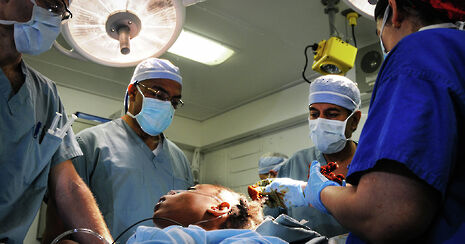How to fix a head injury? Remove the skull
New research shows that craniectomy – or removal of part of the skull – significantly reduces the risk of death after a head injury.

Traumatic head injuries - such as those caused by road accidents or severe falls - typically cause severe damage to the brain. The body responds by generating swelling, much like the lumps which form after heavy bruising, but in this case the swelling occurs on the brain. Given that the brain is enclosed in the skull, significant swelling leads to a build-up of pressure and the possibility of brain damage or death.
Craniectomy is a technique which involves removing part of the skull (a bone flap), with the aim of alleviating the intense pressure build-up. A 10-year study led by Cambridge’s Peter Hutchinson, published in the New England Journal of Medicine, found that 73 per cent of craniectomy patients survived, compared with the survival rate of 51 per cent under conventional medical practice.
The follow-up results were also – generally – positive. While 30 per cent of surviving craniectomy patients became dependent on others for care, compared with 17 per cent of surviving medical management patients, there was an overall improvement in the independence of survivors, with 45 per cent of craniectomy patients being at least independent at home compared with 32 per cent of medical management patients.
This research is significant as the first major study to demonstrate a clear difference in survival rates. However, Prof. Hutchinson was keen to stress that further issues remain, saying that “we need to be really conscious of the quality of life of patients following this operation, which ranged from vegetative state through varying states of disability to good recovery.”
Varsity recommends that, despite the breakthrough, it’s not time to lose the cycle helmet just yet.
 News / Cambridge University disables comments following Passover post backlash 24 April 2024
News / Cambridge University disables comments following Passover post backlash 24 April 2024 Comment / Gown vs town? Local investment plans must remember Cambridge is not just a university24 April 2024
Comment / Gown vs town? Local investment plans must remember Cambridge is not just a university24 April 2024 News / Fitz students face ‘massive invasion of privacy’ over messy rooms23 April 2024
News / Fitz students face ‘massive invasion of privacy’ over messy rooms23 April 2024 Interviews / Gender Agenda on building feminist solidarity in Cambridge24 April 2024
Interviews / Gender Agenda on building feminist solidarity in Cambridge24 April 2024 Comment / Does Lucy Cavendish need a billionaire bailout?22 April 2024
Comment / Does Lucy Cavendish need a billionaire bailout?22 April 2024





